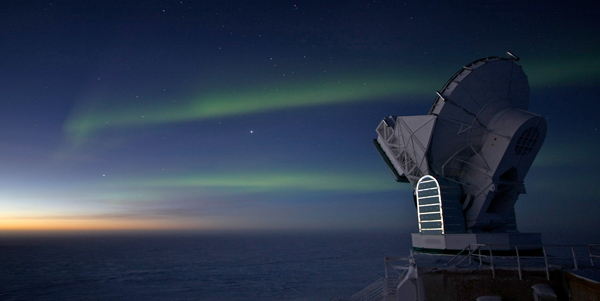
Physics World cites work by South Pole Telescope team
By Chris Chipello
Scientists in McGill’s Astrophysics group have been honoured in Physics World magazine’s list of top 10 breakthroughs in physics for 2013.
Astronomers on the South Pole Telescope international team, including several from McGill, were recognized by the magazine for being the first to measure certain patterns in the universe’s oldest light – a discovery that opens the way to test a key theory in the Big Bang model of the universe. The magazine, published by the Institute of Physics, unveiled its list today (Dec. 13).
Physics World reported last July that the South Pole Telescope (SPT) collaboration had made the first detection of a subtle twist, known as B-mode polarization, in light from the cosmic microwave background (CMB). “The signal, the existence of which has been long predicted, paves the way for a definitive test of inflation,” the universe’s dramatic expansion in the moments following the Big Bang, the magazine reported.
McGill postdoctoral researcher Duncan Hanson was lead author of the study. Co-authors from the multi-institutional collaboration include McGill professors Matt Dobbs and Gil Holder as well as researchers Amy Bender, Tijmen de Haan and Graeme Smecher. The SPT collaboration is led by University of Chicago Prof. John Carlstrom.
The subtle distortions in CMB light, which is often known as the “afterglow of the Big Bang,” are caused by the gravitational effects of matter on the light during its 14-billion-year journey across the observable universe.
“Observation of these difficult to see twisting patterns represents a major achievement and a big step in providing a pathway to tease out information about the earliest moments of the universe, before even the creation of the CMB light itself,” the U.S. Department of Energy’s Office of Science noted in an August article about the South Pole Telescope findings.
Light from the cosmic microwave background is polarized mainly due to the scattering of photons off of electrons in the early universe, in the same way that light is polarized as it reflects off the surface of a lake. Gravitational lensing, it has long been predicted, can twist polarization patterns into so-called B-modes as photons pass by massive objects on their way to earth. The South Pole Telescope study confirmed that expectation.
The 10-metre SPT, built partly by McGill astrophysicists, is located at the National Science Foundation Amundsen-Scott South Pole Station. The SPT is designed to conduct low-noise, high-resolution surveys of the sky with the particular design goal of making ultra-sensitive measurements of the cosmic microwave background.
In the SPT team’s research reported this year, the collaboration used the European Space Agency’s Herschel space observatory to map the cosmic infrared radiation, and used that information to estimate the distribution of mass in the universe. They then calculated its effect on the South Pole Telescope’s own map of a patch of sky to create a template that enabled them to tease out B-modes in the data.
These findings could open a path to the bigger goal of confirming the inflation theory.
While most cosmologists today believe in inflation, “the theory lacks details such as how it started and stopped and there has been no way to test it,” Physics World noted in its July article on the SPT findings. B-mode signals, the magazine noted, could be used to “uncover evidence of primordial gravitational waves – gargantuan ripples in space-time” thought to have been generated during the brief period after the Big Bang when the universe underwent rapid expansion.
Researchers, including those in the South Pole Telescope collaboration, are already pursuing that goal.
The gravitational lensing “signature” reported by the SPT team this year stems from a period roughly two billion to six billion years after the Big Bang, Dobbs explains. But “the technique we used may allow us to see the time of inflation a tiny fraction of a second after the Big Bang,” he adds.
“The detection of a primordial B-mode polarization signal in the microwave background,” says Hanson, would amount to “finding the first tremors of the Big Bang,”
The paper by Hanson and other team members was published in the journal Physical Review Letters, Vol. 111, Issue 14, 2013. The paper can be read here.
The criteria for judging the Physics World top 10 breakthroughs included: fundamental importance of research; significant advance in knowledge; strong connection between theory and experiment; general interest to all physicists. The full article can be viewed here.
The Institute of Physics, a leading scientific society, is a UK-based charitable organization with a worldwide membership of more than 50,000, working together to advance physics education, research and application. (Visit www.iop.org.)
The McGill researchers on the South Pole Telescope project received funding from the National Sciences and Engineering Research Council of Canada, the Canada Research Chairs Program, and the Canadian Institute for Advanced Research. The research project also used resources of the CLUMEQ supercomputing consortium, part of the Compute Canada network
